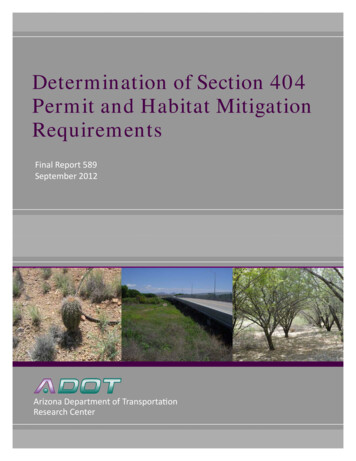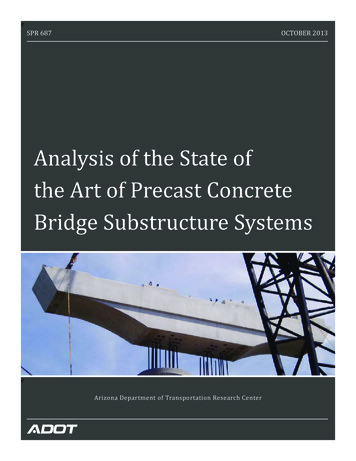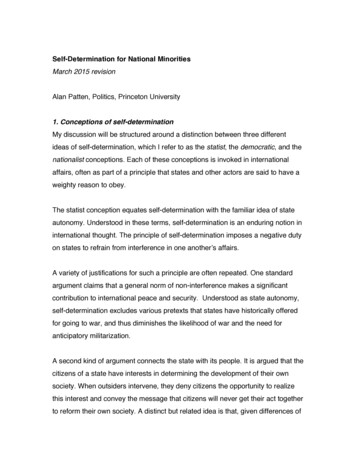
Transcription
Determination of Section 404Permit and Habitat MitigationRequirementsFinal Report 589September 2012Arizona Department of TransportaƟonResearch Center
DETERMINATION OF SECTION 404PERMIT AND HABITAT MITIGATIONREQUIREMENTSFinal Report 589September 2012Prepared by:Greg Martinsen, Timothy Wade, and Tricia BalluffEcoPlan Associates, Inc.701 West Southern Avenue, Suite 203Mesa, Arizona 85210Prepared for:Arizona Department of Transportationin cooperation withU.S. Department of TransportationFederal Highway Administration
This report was funded in part through grants from the Federal Highway Administration,U.S. Department of Transportation. The contents of this report reflect the views of theauthors, who are responsible for the facts and the accuracy of the data, and for the useor adaptation of previously published material, presented herein. The contents do notnecessarily reflect the official views or policies of the Arizona Department ofTransportation or the Federal Highway Administration, U.S. Department ofTransportation. This report does not constitute a standard, specification, or regulation.Trade or manufacturers’ names that may appear herein are cited only because they areconsidered essential to the objectives of the report. The U.S. government and the Stateof Arizona do not endorse products or manufacturers.
Technical Report Documentation Page1. Report No.2. Government Accession No.3. Recipient's Catalog No.FHWA-AZ-12-5894. Title and Subtitle5. Report DateSeptember 20126. Performing Organization CodeDETERMINATION OF SECTION 404 PERMIT AND HABITATMITIGATION REQUIREMENTS7. Author8. Performing Organization Report No.Greg Martinsen, Ph.D., Timothy Wade, andTricia Balluff07-0359. Performing Organization Name and Address10. Work Unit No.EcoPlan Associates, Inc.701 West Southern Avenue, Suite 203Mesa, Arizona 8521011. Contract or Grant No.SPR-PL 1 (67) 58912. Sponsoring Agency Name and Address13.Type of Report & Period CoveredArizona Department Of Transportation206 South 17th AvenuePhoenix, Arizona 85007FINAL REPORTMay 2007 – December 201114. Sponsoring Agency CodeADOT Project Manager: Estomih (Tom) Kombe, Ph.D., P.E.15. Supplementary NotesPrepared in cooperation with the US Department of Transportation, Federal Highway Administration16. AbstractThe Arizona Department of Transportation (ADOT) is committed to developing habitat, mitigation,monitoring, and maintenance plans that replace the loss of the functions and values of an area andare self-sustaining, thereby providing long-term compensation for habitat adversely affected by ADOTconstruction activities. This study focuses on identifying administrative and biological criteria that areimportant to the success or failure of mitigation and/or restoration projects and developingrecommendations from these criteria. Files on ADOT and non-ADOT riparian habitat restoration andmitigation projects were obtained from several sources and were reviewed for project applicability tothe study goals. Thirty-four sites were selected for further analysis. In addition, employees from theCorps and ADOT were interviewed to gain a realistic perspective. A review of project files, associatedsite data sheets, and analysis of the interview results yielded mitigation practices and a variety ofadministrative and biological problems commonly associated with restoration projects in Arizona.More specifically, the problems are associated with ADOT mitigation projects for which Clean WaterAct Section 404 permits are involved. Recommendations based on analysis of these problems, reviewof applicable peer-reviewed literature, and research team expertise, are offered in this report to aidfuture ADOT projects and all future restoration projects in Arizona, regardless of the agency ororganization undertaking the restoration of riparian areas.17. Key Words18. Distribution StatementRiparian, restoration, mitigation, Section 404,Arizona, ADOTDocument is available to theUS public through the NationalTechnical Information Service,Springfield, Virginia 2216119. Security Classification20. Security Classification21. No. of PagesUnclassifiedUnclassified7822. Price23. Registrant's Seal
SI* (MODERN METRIC) CONVERSION FACTORSAPPROXIMATE CONVERSIONS TO SI UNITSSymbolWhen You KnowMultiply squaresquaresquareacressquarefl ozgal3ft3ydfluid ouncesgallonscubic feetcubic yardsozlbTouncespoundsshort tons (2000 /inpoundforcepoundforce per square inchSymbolWhen You 050.9141.61To quare millimeterssquare meterssquare metershectaressquare kilometersmm2m2mha2kmmillilitersliterscubic meterscubic meters3shown in mmLL3m3mgramskilogramsmegagrams (or "metric ton")gkgMg (or s2VOLUME29.573.7850.0280.765NOTE: volumes greater than 1000 L shall beMASS28.350.4540.907TEMPERATURE (exact degrees)F5 (F-32)/9or N10.763.426FORCE and PRESSURE or STRESS4.456.89newtonskilopascalsNkPaAPPROXIMATE CONVERSIONS FROM SI UNITSMultiply ByLENGTH0.0393.281.090.621To a2kmsquare millimeterssquare meterssquare metershectaressquare OLUMEmLL3m3mmillilitersliterscubic meterscubic meters0.0340.26435.3141.307gkgMg (or "t")gramskilogramsmegagrams (or "metric ton")oCelsiusfluid ouncesgallonscubic feetcubic yardsfl ozgal3ft3ydouncespoundsshort tons (2000 lb)ozlbTMASS0.0352.2021.103TEMPERATURE (exact degrees)C1.8C 9290.2919FORCE and PRESSURE or STRESS0.2250.145poundforcepoundforce per square inchlbf2lbf/in*SI is the symbol for the International System of Units. Appropriate rounding should be made to comply with Section 4 of ASTM E380.(Revised March 2003)
CONTENTSExecutive Summary . 1Chapter 1. Introduction. 7Chapter 2. Methods . 9Site Visits . 9Interviews . 9Chapter 3. Results . 11Project File Review and Site Visits . 11Mitigation Practices . 11Tall-Pot Plantings. 11Planting Stock Collected On-Site . 13Nursery Stock Planted. 13Preplanting Soil Testing. 14Replacement of Dead or Unhealthy Trees . 14Salvaged/Transplanted Saguaros . 15Seeding/Hydroseeding . 15Administrative Process Mitigation Problems . 16Failure to Monitor Mitigation Plantings . 16Failure to Inspect Irrigation or Irrigation Removed Prematurely . 18Mitigation Not Completed . 19Mitigation Monitor Not Qualified . 19Staff Turnover . 20Overplanting . 20No Irrigation. 21No Reference Plot . 21Revised Mitigation . 21Biological Mitigation Problems . 22Animal Damage . 22Flooding . 22Animal Damage to Irrigation Lines . 24Transplant Shock . 24Drought Stress . 25Insects and Pests . 25Tamarisk . 25Invasive Species . 26Root-Bound Nursery Plants . 27Mistletoe . 27Heat-Damaged Roots in Tall-Pot Plantings . 27Fire . 28Interviews . 28ADOT Interviews . 32Administrative Processes . 32Biological Factors . 35Corps Interviews . 37
Administrative Processes . 37Chapter 4. Discussion . 41Chapter 5. Recommendations . 45Administrative Processes . 45Biological Factors. 48References . 53Appendix: Case Studies . 55Case Study 1: ‘Ahakhav Tribal Preserve . 56Case Study 2: Covered Wells, Why–Tucson Highway (SR 86) . 59Case Study 3: SR 89A, Cornville Road to Sedona, Arizona . 61Case Study 4: SR 75, Gila River Bridge #311 . 65Case Study 5: Peck Canyon Bridges . 67
LIST OF FIGURESFigure 1. Mitigation Practices . 12Figure 2. Administrative Process Mitigation Problems . 17Figure 3. Biological Mitigation Problems. . 23Figure 4. Evenly Spaced Plantings at the Northern End of the‘Ahakhav Tribal Preserve Project Site . 58Figure 5. Dense Cover Behind the ‘Ahakhav Tribal Preserve Nursery . 58Figure 6. Relocated Saguaros at the Western End of the Covered Wells,Why–Tucson Highway (SR 86) Project Site. . 60Figure 7. An Actively Growing Saguaro Near the Irrigation Tube at theCovered Wells Why–Tucson Highway (SR 86) Project Site . 60Figure 8. Revegetated Area Adjacent to and West of the SR 89A,Cornville Road to Sedona Project Site (Facing North) . 63Figure 9. Revegetated Area Adjacent to and West of the SR 89A,Cornville Road to Sedona Project Site (Facing South). . 64Figure 10. The 40-Foot-Wide Mitigation Strip Along the West Side of theSR 75, Gila River Bridge #311 Project Site . 66Figure 11. Dense, Naturally Recruited Riparian Trees Along the West Side of theSR 75, Gila River Bridge #311 Project Site . 66Figure 12. Pole Planting Knocked Down by Flooding at Peck Canyon BridgesProject Site, Between the Frontage Road and the I-19 Bridges. . 69Figure 13. Growing and Dead Pole Plantings Downstream at the PeckCanyon Bridges Project Site . 69LIST OF TABLESTable 1. Comments from ADOT Interviews . 28
LIST OF ACRONYMSADOTArizona Department of TransportationADWRArizona Department of Water ResourcesAGFDArizona Game and Fish DepartmentDECdistrict environmental coordinatorEPAEnvironmental Protection AgencyEPGEnvironmental Planning GroupFHWAFederal Highway AdministrationFCDMCFlood Control District of Maricopa CountyMPmilepostNEPANational Environmental Policy ActNGOnon-governmental organizationNWPnationwide permitPVCpolyvinyl chlorideSRstate routeTItraffic interchange
ACKNOWLEDGMENTSThe authors would like to express appreciation to members of the Arizona TransportationResearch Center Technical Advisory Committee for sharing expertise and providinginput on this final report. We also appreciate the many employees of federal, state, andcounty agencies; nonprofit organizations; and private entities who gave of their time andshared their expertise in the interviews and on-site visits. We thank The Flood ControlDistrict of Maricopa County for its aid in locating tall-pot planting sites and the ArizonaDepartment of Water Resources for allowing access to its files on riparian mitigationprojects.
EXECUTIVE SUMMARYUsing current U.S. Army Corps of Engineers (Corps) guidelines as the backdrop, thisstudy focuses on determining administrative processes and biological factors that areimportant to the success or failure of land restoration and disturbance mitigation projects.Data were collected by identifying past or ongoing projects of the Arizona Department ofTransportation (ADOT) and other agencies that have habitat restoration or disturbancemitigation components, conducting site visits as needed, and interviewing Corps projectmanagers and ADOT employees who work with mitigation projects. The data were usedto assess the condition of mitigation plantings at these projects and from this analysis, toidentify factors important to the success or failure of such projects.ADOT and the Federal Highway Administration (FHWA) are committed to mitigatingthe ecological impact of ADOT construction on an area. They do this by executing plansthat provide for the replacement of lost habitat with plants that will be self-sustaining inthe long run. ADOT has concluded that its projects too often fail to meet the plantingsuccess criteria contained in the mitigation requirements of Corps’ Clean Water Act,Section 404, permits. When these requirements are not initially met, the replantings andextension of monitoring periods needed to do so create time and cost burdens for ADOT,the FHWA, and Arizona taxpayers. ADOT and the FHWA have concluded that researchis needed to ensure that mitigation developed for future ADOT projects meets the criteriarequired by the Corps.MethodsFiles on ADOT and non-ADOT habitat restoration and land disturbance mitigationprojects were obtained from the Corps; internal EcoPlan Associates, Inc. (EcoPlan)project files; the University of Arizona Water Resources Research Center; and theArizona Department of Water Resources (ADWR). The files were reviewed to determineproject goals, the level of available detail such as planting plans and follow-upmonitoring reports, and overall file completeness. Researchers selected 34 projects fordetailed study: 19 ADOT projects, four projects from the Flood Control District ofMaricopa County (Flood Control District), and 11 restoration projects undertaken byprivate entities or non-governmental organizations (NGOs). Of these 34 projects, 23 wereselected for further evaluation through site visits by EcoPlan biologists. Eleven of thesites visited were ADOT project sites, four were Flood Control District sites, and eightwere private or NGO sites. Researchers used information in the file and fieldobservations to make an overall determination of each project’s success.One-on-one interviews with select Corps and ADOT employees provided importantinsights into the causes of success or failure of mitigation projects. Researchers obtainedfirsthand knowledge from individuals who are, or should be, involved in the mitigationprocess. ADOT employees were interviewed using a standardized set of questions tofacilitate comparison and analysis of responses.1
ResultsA review of project files, site visit observations, and associated site visit data sheets andphoto logs yielded seven common mitigation practices: Planting stock collected at the site. Planting nursery stock. Planting stock raised in tall pots. Testing the soil before planting. Replacing dead trees on a regular basis. Salvaging and transplanting saguaros. Seeding or hydroseeding.These practices have varying levels of success.The project file review and associated site visits also yielded a list of problems thatoccurred during the mitigation projects, although these did not always lead to failure.Many of the projects had multiple problems, which increased their potential to fail. Theproblems were divided into two main categories: administrative processes and biologicalfactors. Some problems, such as unmaintained irrigation, were classified as both.Administrative process problems were: Failure to monitor mitigation plantings. Failure to inspect the irrigation system. Premature removal of irrigation systems. Not initiating or not completing the planned mitigation work. Mitigation monitors who lacked monitoring experience. Disconnects in project knowledge and follow-through caused by staff turnover. Overplanting. Not irrigating. Not using a reference plot to create mitigation or planting plans. Revising mitigation plans due to an unsuccessful original plan.Biological factor problems were: Direct damage to the planted vegetation from wildlife, cattle, or both. Wildlife damage to irrigation lines. Transplant shock. Drought stress. Insect and pest damage. Invasion of the project site by tamarisk or other invasive plants. Root-bound nursery plants. Parasitic infestation by mistletoe. Improper handling of tall-pot container trees prior to planting. Natural events such as flooding and fire.2
Results of the interviews with Corps and ADOT employees were subjective and variable,so those data were analyzed in a slightly different manner from the other data. Commentswere categorized as either administrative process or biological factor, with the followingsubcategories added to clarify the results:Administrative processes: In-lieu fees and other off-site mitigation. Responsible parties. Staffing and training. Other agency involvement. Mitigation plans and monitoring.Biological factors: Planting. Seeding.ADOT employees were split between opposition and support for in-lieu fees: Fiverespondents opposed and eight favored use of in-lieu fees as a mitigation method. Mostinterviewees agreed that ADOT should designate a staff position responsible fordeveloping mitigation plans and monitoring their completion from project beginningthrough final acceptance by the Corps. Employees most commonly suggested the ADOTdistrict environmental coordinator (DEC) as the responsible position.The issue of staffing and training came up tangentially during some of the interviews,where it was noted that there is an overall need for dedicated, local personnel who areinvolved with each project and for increased cross-training among all employees soeveryone understands all of the components of a project, including mitigation work.Interviewees indicated that mitigation and planting plans should be developed bysomeone with experience in desert ecology, not by someone whose experience is limitedto urban landscaping only.According to interviewees, working with multiple agencies on one project can be difficultbecause of differing goals and priorities, making mitigation less likely to succeed. Threeinterviewees suggested that the Corps be involved in the process from the beginning toensure everyone agrees on a mitigation plan’s goals and success criteria.Five ADOT employees indicated that mitigation plans and monitoring need to havespecific success criteria; three said plans should be site-specific. Five ADOT employeessaid that monitoring should be conducted by consultants; three said these consultantsshould have a minimum of two or three years of experience.Biological factors were fairly wide ranging, but the most commonly stated problems wereissues with irrigation, seasonality, and animal damage to plantings. Many ADOTinterviewees were unfamiliar with using tall-pot plantings to minimize irrigation needs.Time of planting was another concern because mitigation plans are often based on theconstruction schedule rather than the biological schedule of plants.3
The interviews with Corps employees only covered administrative process issues andyielded many of the same responses as the ADOT employee interviews. However, theCorps project managers in general favored the use of in-lieu fees. Five project managersmentioned problems obtaining permittee compliance with mitigation requirements ofSection 404 permits, including monitoring and reporting. Mitigation plans often lackrequired information. One project manager saw insufficient monitoring and complianceas one of the biggest problems. Another said that ADOT’s chain of responsibility is notstrong enough and does not hold contractors sufficiently responsible for their actions orinactions.DiscussionThough many problems were identified, inefficiency was frequently noted by ADOT andCorps interviewees. For example, mitigation plans that are not based on desert ecologyand local conditions ultimately fail and require replanting and extended monitoring. Thiscauses additional expense for ADOT, the contractor, or both.Another problem they noted was inadequate planning, monitoring, and maintenance ofthe irrigation system, and seasonal adjustment of the frequency and duration ofsupplemental water. Failure of the irrigation system or application of insufficient depthand frequency of supplemental water most often results in failure of the mitigationplantings.In some cases, disconnects occur when projects transition between employees ordepartments, making it difficult to follow the progress of mitigation and maintainoversight of the contractor.Clear objectives, specific measures of success, and a clearly defined monitoring plandetailed in the mitigation plan are key to project success. Replacement ratios should bebased on site-specific characteristics and the use of multiple reference plots. Cooperationwith the Corps and other agencies in the early phases of the project will ensure that allagencies understand the objectives and success criteria of a mitigation project. Aqualified ADOT employee or consultant should develop mitigation plans; planimplementation should include biological timing considerations.If no viable on-site or nearby off-site opportunities exist for compensatory mitigation, inlieu fees should be considered. The Corps rule regarding mitigation, “CompensatoryMitigation for Losses of Aquatic Resources,” which became effective June 9, 2008,encourages the use of in-lieu fees over permittee-responsible mitigation. According toCorps managers, in-lieu fees may especially be appropriate for linear projects where theimpacts are small and occur within the right of way.4
RecommendationsA partial list of recommendations that were developed based on the data analysis is givenbelow. A complete list of recommendations is given in Chapter 5.Administrative processes: Enlist an ADOT employee or consultant with a clear understanding of naturalenvironments and a background in landscape ecological design, landscapeecological restoration, plant biology, or restoration ecology to develop andmonitor land disturbance mitigation plans. Create mitigation plans that outline clear performance objectives with specificsuccess criteria and a monitoring plan that defines the quantitative data needed todetermine success. Designate an ADOT staff position responsible for following all mitigationprojects—from initial development through implementation, monitoring, and finalacceptance by the Corps—to ensure that each project has met success criteria. Allemployees in that position should have a similar understanding of theirresponsibilities and receive training, if warranted.Biological factors: Provide exclusionary fencing or other plant protection around each planting orplanting site in areas prone to wildlife or cattle damage. Ensure irrigation lines are regularly monitored and maintained. Irrigate plantings for at least two years to ensure adequate root systemdevelopment. Monitor plantings for at least five years, as required by the Corps—two yearsduring irrigation and three years after irrigation ceases. Turn off irrigation only if the site is meeting or exceeding the required successcriteria.5
.6
CHAPTER 1. INTRODUCTIONADOT’s mission is to provide products and services for a safe, efficient, cost-effectivetransportation system that links Arizona to the global economy, promotes economicprosperity, and demonstrates respect for Arizona’s environment and quality of life.Fulfilling this mission sometimes entails unavoidable impacts to jurisdictional Waters ofthe United States (Waters). In keeping with the Clean Water Act, these impacts must bemitigated according to direction from the Corps and the Environmental ProtectionAgency (EPA).ADOT is committed to developing and implementing mitigation plans that provide longterm compensation for habitat adversely affected by its construction activities. Themitigation must be self-sustaining in perpetuity. To ensure that mitigation strategiesdeveloped for future ADOT projects meet these goals, research and subsequent analysisare needed. Any mitigation plan ADOT develops and adopts must further the Corps’ goalof no net loss of Waters while remaining cost-effective.ADOT has concluded that its projects too often fail to meet the planting success criteriaof the mitigation requirements of the Corps’ Clean Water Act, Section 404, permits.These permits typically require replacing plants (usually trees) that are damaged orremoved as a result of a construction project at a 3:1 ratio. The permits usually requirethat the planted trees have an 80 percent success rate five years after being planted and aminimum of two years after supplemental watering sources have been removed. Whenthese criteria are not met, the consequent replantings and extensions of mandatedmonitoring periods create substantial time and cost burdens for both ADOT and Arizonataxpayers.Plantings can fail for many reasons. Site conditions may be inappropriate, a site may notbe properly prepared, or planting stock may have been improperly handled beforeplanting. The supplemental water required to establish plantings may not be provided inthe quantity, frequency, or length of time needed for plants to establish adequate rootsystems that enable long-term survival without irrigation. Also, typical planting successcriteria required by the Corps permit may be unattainable. The planting densities andsurvival percentage required in many Corps permits at the end of a typical three- to fiveyear monitoring period frequently cannot be met because the required plant densities aretoo high to be sustainable without long-term irrigation. Even with favorable rainfallconditions, a substantial number of plants die when supplemental watering is stopped andsuccess criteria may not be met. In the current long-term drought, the required survivalrate for excessively dense plantings is even more difficult to achieve.The April 19, 2004, Corps’
Cornville Road to Sedona Project Site (Facing North) . 63 Figure 9. Revegetated Area Adjacent to and West of the SR 89A, Cornville Road to Sedona Project Site (Facing South). . 64 Figure 10. The 40-Foot-Wide Mitigation Strip Along the West Side of the










